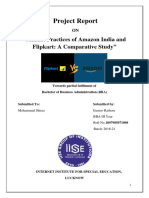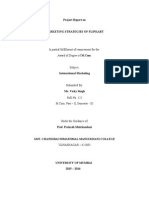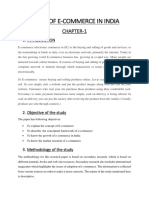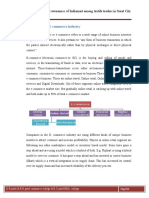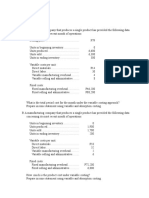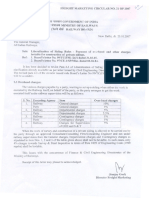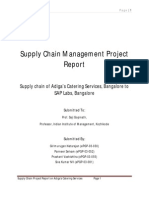Chapter-1: E-Commerce On Flipkart
Chapter-1: E-Commerce On Flipkart
Uploaded by
ajadaaryan786Copyright:
Available Formats
Chapter-1: E-Commerce On Flipkart
Chapter-1: E-Commerce On Flipkart
Uploaded by
ajadaaryan786Original Title
Copyright
Available Formats
Share this document
Did you find this document useful?
Is this content inappropriate?
Copyright:
Available Formats
Chapter-1: E-Commerce On Flipkart
Chapter-1: E-Commerce On Flipkart
Uploaded by
ajadaaryan786Copyright:
Available Formats
E-COMMERCE ON FLIPKART
CHAPTER-1
INTRODUCTION
1.1: Introduction.
Electronic commerce, commonly known as E-commerce is trading in
products and services using computer networks, such as the internet. Electronic
commerce draws on technology such as mobile commerce, electronic fund
transfer, supply chain management, internet marketing, online transaction
processing, electronic data interchange (EDI), inventory management system
and automated data collection systems. Modern electronic commerce topically
uses the World Wide Web for at least one part of the transactions life cycle,
although it may also use other technologies such as e-mail.
E-Commerce businesses may some all of the following:
Online shopping web site for retail sales direct to consumers.
Providing and participating in online marketplace, which process
third-party business to consumer or consumer to consumer sales.
Business to business buying and selling.
Gathering and using demographic through web contract and social
media.
Business to business electronic data interchange.
Marketing to prospective and established consumes e-mail and
fox.(for example, with slitters)
Engaging and pertain for launching new products and services.
According to an associated chamber of commerce and industry in
India. (ASSOCHAM) survey, the online retail in India grow to Rs. 70 billion
(over Rs. 1.5 billion) by 2015 Rs.20 billion in 2011 as internet access improved.
Dr.P.R.K Degree College. 1
E-COMMERCE ON FLIPKART
India has always been a land of great potential. The social economic
conditionof the country has improved many folds after independence and India is
now emerging as one of the leading countries in the world. Moreover with a
population over 100 crore and growth rate is above 6%, it can be compared to a
marketing giant. Hence it can be well judged why online shopping in India is rise
at fast pace over the day. As technology is seared to a remotest village and many
job opportunities are presenting themselves to the unemployed youth and
more and more people are gaining awareness and the money to purchase
expensive and luxuries item over the internet.
1.1.1 Online shopping
Let us talk about the home-grown India e-commerce site “flipkart” also
considers as the Amazon of India.A company which started with just 4 lakhs is
now worth is over more than 2000 crore, according to data flipkart has provided to
Ministry of Corporate Affairs: the companies revenue is 2011-2012 was $77
Million (Rs. 500 crore). For the fiscal 2012-2013, their revenue is estimated to be
$350 Million. With this huge success flipkart is becoming the fate of online retail
in India. This paper attempt to through light and growth of online retail in
business in India with special reference to flipkart (analyzing the consumers
feedback about the online businessmodel of flipkart).
Dr.P.R.K Degree College. 2
E-COMMERCE ON FLIPKART
The invention has opened the whole new world of possibilities for us. Not
onlywe can communicate with the we love with in moment but now a day many
vital tasks like job, shopping, socializing and many others can be done easily at
the convenience of the homes. The concept of online shopping is relatively
new one and it enables us to buy all our favourite goods and accessories over the
internet. This will not only save the time but also we can get the product at much
discounted price and that too all our homes. There are many online storesthat have
developed in recent times like lets shops.in, flipcart.com and many others. This
stores host a wide range of products like bags, shoes, books, gadgets and many
others. To purchase any product you have to visit the site and click on the
product that you would like to purchase and the product will be delivered to you
within a week maximum. It’s that simple.
1.1.2: Growth of online retailing in India
Dr.P.R.K Degree College. 3
E-COMMERCE ON FLIPKART
India e-commerce has grown at a compounded annual growth rate of
30% since FY09, and is expected to be $18 billion (around Rs.1,11,600 crore)
opportunity by FY15. The findings part of report: Indian Ecommerce – Tip of the
Iceberg, by Macquarie Equities Research back this high growth rate on rising
internet population, over 300 million middle class populations, increasing mobile
penetration and low level of e-commerce activity.
“Compared to the west, India’s e-commerce industry is still in its infancy.
E-commerce contributes only 0.6% of the country GDP was 1-3% for other
countries, with only 12% of India’s online population transacting online vs 64%
for the US and over 50% for China.” Said Atul Soni and Nitin Mohta in the
report. This growth will further be accentuated by companies going in for public
listing. In the Indian context, only two internet-based companies are listed on the
markets, including info edge, which runs India’s largest job portal (naukri.com),
and just dial, which is India’s largest local search site.
The nature of Indian e-commerce is also different. Travel has the lions
share of 71% of Indian e-commerce, but e-tailing has grown the fastest, at a 59%
CAGR between FY09-13E, to reach 16% market share. Compared to the west,
India’s e-commerce industry is still in its infancy, but we believe that it may
become a bigger part of the entire retail universe than in the west.
Flipkart Private Limited is an Indian e-commerce company, headquartered
in Bangalore, and incorporated in Singapore as a private limited company. The
company initially focused on online book sales before expanding into other
product categories such as consumer electronics, fashion, home essentials,
groceries, and lifestyle products.
The service competes primarily with Amazon India and domestic
rival Snapdeal. As of FY23, Flipkart held a 48% market share in the Indian
E-Commerce industry. Flipkart has a dominant position in the apparel segment,
bolstered by its acquisition of Myntra, and was described as being "neck and
neck" with Amazon in the sale of electronics and mobile phones.
Dr.P.R.K Degree College. 4
E-COMMERCE ON FLIPKART
1.2 Significance of the organizational Study:
An organizational study of Flipkart can reveal insights into various aspects of
the company’s operations, strategy, and culture. Here are several significant
areas:
1. Business Model and Strategy: Understanding Flipkart’s approach to e-
commerce, including its market segmentation, value proposition, and
competitive strategies. This includes how Flipkart differentiates itself from
competitors like Amazon and other regional players.
2. Operational Efficiency: Examining Flipkart’s supply chain management,
logistics, and warehousing strategies. This includes their methods for
inventory management, order fulfillment, and distribution, which are crucial
for an e-commerce platform’s success.
3. Technology and Innovation: Analyzing Flipkart’s use of technology to
drive growth. This includes their investments in technology infrastructure,
data analytics, artificial intelligence, and customer experience enhancements.
4. Organizational Structure and Culture: Exploring Flipkart’s internal
organizational structure, management practices, and corporate culture. This
can provide insights into how the company fosters innovation, maintains
employee satisfaction, and supports leadership development.
5. Customer Experience: Assessing how Flipkart manages customer service,
feedback, and satisfaction. This involves understanding how they handle
customer interactions, resolve issues, and ensure a positive shopping
experience.
6. Financial Performance: Reviewing Flipkart’s financial health through its
revenue streams, profitability, and investment strategies. This includes
examining financial reports, funding rounds, and economic challenges.
7. Market Position and Expansion: Evaluating Flipkart’s market share,
growth strategies, and expansion plans, both domestically and internationally.
This includes their approach to new market entry, partnerships, and scaling
operations.
8. Regulatory and Ethical Issues: Investigating how Flipkart navigates legal
and ethical challenges, including compliance with local regulations, data
privacy laws, and corporate social responsibility initiatives.
Dr.P.R.K Degree College. 5
E-COMMERCE ON FLIPKART
1.3 Objectives of Study:
The objectives of Flipkart, as a leading e-commerce platform in India, can be
categorized into several strategic and operational goals:
1. Market Position Analysis:
This objective aims to understand Flipkart's place within the e-commerce
market. By assessing market share and competitive positioning, the study will
reveal how Flipkart compares to rivals like Amazon and local competitors,
2. Customer Demographics:
Investigating customer demographics involves analysing who buys from
Flipkart, including details like age, income, location, and shopping behaviour.
This helps tailor marketing strategies, product offerings, and customer service
to better meet the needs of different consumer segments.
3. Business Model Evaluation:
This objective examines how Flipkart generates revenue (e.g., through sales,
ads, or subscriptions) and manages costs (e.g., logistics, technology, and
marketing). Understanding the business model provides insights into
operational efficiency and profitability.
4. Customer Experience Assessment:
Evaluating customer experience focuses on how users perceive and interact
with Flipkart’s platform. This includes analysing aspects like website
usability, customer service quality, delivery times, and overall satisfaction to
identify areas for improvement.
5. Technology and Innovation Review:
This objective involves studying the technology Flipkart uses, such as its
website infrastructure, mobile app features, and data analytics tools. It also
explores innovations like AI and machine learning that enhance the shopping
experience or streamline operations.
Dr.P.R.K Degree College. 6
E-COMMERCE ON FLIPKART
1.4 Methodology:
Data Collection Method:
a) Primary Data:
Primary data was collected through the survey method
(questionnaire observation and interview) from the respondents.
Observations regarding the rise of online shopping trends. The
questionnaires aimed at studying the customer’s preference and
feedback for the online shopping sites flipkart. Unstructured
interview was conducted for some of the respondents to find out the
drawbacks of the online model of flipkart.
b) Secondary data:
Secondary data was collected through various websites and articles
available on the internet.
1.5 Limitations:
1. Intense Competition: Flipkart competes with global giants like Amazon and
local players such as Reliance’s Jio Mart. This intense competition puts
pressure on pricing, market share, and customer retention.
2. Profitability Challenges: Flipkart has struggled with profitability due to high
operational costs, including logistics and marketing expenses. Despite
revenue growth, achieving consistent profitability remains a challenge.
3. Logistics and Delivery Issues: Managing an extensive supply chain and
ensuring timely deliveries can be complex and costly. Issues such as delays,
high shipping costs, and logistics inefficiencies can impact customer
satisfaction.
4. Regulatory and Compliance Hurdles: Navigating various regulatory
requirements, including data protection laws and e-commerce regulations,
can be challenging and costly. Compliance with local and international laws
adds to operational complexity.
5. Dependence on Discounts and Offers: Flipkart often relies on heavy
discounts and promotional offers to drive sales. This dependence can erode
profit margins and create a perception of low value when not running
promotions.
Dr.P.R.K Degree College. 7
E-COMMERCE ON FLIPKART
6. Scalability Concerns: As Flipkart grows, scaling its operations, technology
infrastructure, and customer service to maintain efficiency and quality can be
difficult and resource-intensive.
7. Customer Service Challenges: Ensuring high-quality customer service
across a large customer base is challenging. Issues with returns, refunds, and
customer support can negatively affect the brand’s reputation.
8. Technology and Cybersecurity Risks: Managing and securing vast amounts
of customer data poses significant risks. Any data breaches or cybersecurity
incidents can lead to legal issues and loss of customer trust.
9. Market Saturation: In mature markets, growth opportunities may be limited
due to market saturation. This can make it harder to attract new customers
and achieve high growth rates.
10. Supply Chain Disruptions: External factors such as natural disasters,
geopolitical tensions, or pandemics can disrupt supply chains, affecting
inventory levels and delivery schedules.
These limitations highlight the various challenges Flipkart faces as it
navigates a competitive and complex e-commerce landscape. Addressing
these issues is crucial for sustaining growth and maintaining a strong market
position.
Concerns: As with any online platform, there are concerns about
data privacy and the security of personal information. Users should
be aware of the platform's privacy
Dr.P.R.K Degree College. 8
E-COMMERCE ON FLIPKART
CHAPTERS-2
INDUSTRY PROFILE AND COMPANY PROFILE
2.1 Industry Profile:
The e-commerce also started a virtual storefront that is dedicated to the
academic needs of students named 'Flipkart Student's Club'. The 'Flipkart Green'
venture was created in 2023 for customers who want to have a sustainable
lifestyle by providing certified sustainable products. Things are easier said than
done! To realize our dreams and that also in such a grand manner is really a tough
task. The founders of Flipkart have probably conquered their dreams with the
amazing success of Flipkart. Flipkart is something which has really opened up the
Indian e-commerce market and that also in a big way. Flipkart was co-founded by
Sachin Bansal and Binny Bansal in Oct 2007. Both are graduates from IIT-Delhi
and have prior work experience in Amazon.com They both were solid coders and
wanted to open a portal that compared different e-commerce websites, but there
were hardly any such sites in India and they decided to give birth to their own e-
commerce venture - Flipkart.com. This was born Flipkart in Oct 2007 with an
initial investment of 4 lakh (co-founders savings). It was never going to be easy
since India has had bad past experiences with e-commerce trading. It was not an
easy segment to break into, people were very particular in paying money for
something which they had not seen and received. The trust was missing in the
Indian customers. So what Flipkart had to do was to instill trust and faith in their
customers. Flipkart began with selling books, since books are easy to procure,
target market which reads books is in abundance, books provide more margin, are
easy to pack and deliver, do not get damaged in transit and most importantly
books are not very expensive, so the amount of money a customer has to spend to
try out one's service for one time is very minimal. Flipkart sold only books for the
first two years.
Flipkart started with the consignment model (procurement based on
demand) i.e. they had ties with 2 distributors in Bangalore, whenever a customer
ordered a book, they used to personally procure the book from the dealer, pack the
book in their office and then courier the same.
Dr.P.R.K Degree College. 9
E-COMMERCE ON FLIPKART
In the initial months the founder's personal cell numbers used to be
the customer support numbers. So, in the start they tried their best to provide good
service, focus on the website - easy to browse and order and hassle-free, and
strove hard to resolve any customer issues. Since there were not any established
players in the market, this allowed them a lot of space to grow, and they did in
fact grew very rapidly.
Flipkart had a revenue of 4 crore in FY 2018- 2019, 20 crore in FY 2020-
2021, 75 crore in FY 2022- 2023, and the revenue for FY 2023 – 2024 which ends
on 31 Sep 2024 is expected to be 500 crore. This is indeed a massive growth. The
company targets revenues of 5000 crore by 2015. The company started from 2
employees and now has around 4500 employees.
Flipkart started with consignment model as discussed above, since most of
the customer issues like delivery delays etc. result from procurement model, the
company started opening its own warehouses as it started getting more
investments. The company opened its first warehouse in Bangalore and later on
opened warehouses in Delhi, Kolkata and Mumbai. Today the company works
with more than 500 suppliers. As on date more than 80% orders of Flipkart are
handled via warehouses which help in quick and efficient service.
A humble beginning from books, Flipkart now has a gamut of
products ranging from: Cell phones, laptops, computers, cameras, games, music,
audio players, TV's, healthcare products, washing machines etc. etc. Still, Flipkart
derives around 50% of its revenue from selling books online. Flipkart is the Indian
market leader in selling books both offline and online, it enjoys an online share of
around 80%. The electronic items have a large number of players like Naptol,
Letsbuy, Indiaplaza, Tradus, Infibeam, Yebhi etc. The electronic market share is
distributed among them in different unknown proportions.
India has around 13.5 crore internet users today where as the
number of homes with Cable and Satellite (C&S) television is 10.5 crore. The
expected internet users will reach a figure of 30 crore by 2014 and C&S homes
are expected to be 14 crore by 2014. Thus India has a tremendous internet growth
and with the customers getting accustomed to e-commerce, the future of e-
commerce sector is definitely rosy.
Dr.P.R.K Degree College. 10
E-COMMERCE ON FLIPKART
Also to mention most of the Flipkart customers use internet from
PC's/Laptops to order goods. The use of mobile internet is very less at the
moment, but with the advent of smart phones the use of mobile internet for e-
commerce transactions will soar with time. India has 8 crore mobile net users at
the moment, the number is expected to swell to 22.5 crore by 2014.
In the financial year 2008-09, Flipkart had made sales to the tune
of 40 million Indian rupees. This soon increased to 200 million Indian rupees the
following year. Flipkart targets to hit the one billion mark by 2015. Going by their
ever increasing popularity, it does not seem like a farfetched thought.
Back at the time when Flipkart was launched, any e-commerce
company faced two major difficulties. One was the problem of online payment
gateways. Not many people preferred online payment and the gateways were not
easy to set up. Flipkart tackled this problem by introducing cash on delivery and
payment by card on delivery in addition to others.
The second problem was the entire supply chain system. Delivering
goods on time is one of the most important factor that determines the success of
an ecommerce company. Flipkart addressed this issue by launching their own
supply chain management system to deliver orders in a timely fashion.
Flipkart also acquired few companies like Myntra.com,
LetsBuy.com etc., to better their presence in the market. With the entry
ofAmazon.com in India, the competition between the companies has seen many
takeovers. Flipkart’s journey from a small book e-retailer to India’s largest e-
commerce platform inspires a generation of start-ups. In a country where
stereotypes are common, Flipkart managed to break the norm and change the
ecommerce industry in India for ever. Flipkart’s story proves that if you have a
great idea, and you are a doer and not a thinker, success is not far off.
Dr.P.R.K Degree College. 11
E-COMMERCE ON FLIPKART
2.2 Company Profile:
Flipkart is an e-commerce company founded in the year 2007 by Sachin Bansal
and Binny Bansal. The company is registered in Singapore, but has its
headquarters in Bengaluru, India. The company seeks to increase traffic (more
clicks on their products) and boost sales and revenue through integration of
Mobile Apps, Display, Pay Per Click and search Engine Optimization. In order to
dispel the fear of people related to shopping online, Flipkart was the first company
to implement to popular ‘Cash on Delivery’ facility. All the products sold by the
company under a particular category may have different return/replacement
period. Flipkart allows multiple payment options such as cash on delivery, credit
or debit card transactions, net banking, e-gift voucher and card swipe on delivery.
The company operates both ways when an order is received. The products
for which it holds inventory are dispatched by it directly. For the products they do
not store in inventory, they just send the order received by them to the supplier
who ships it. The company plans to spend about ₹ 75 crores on e-commerce
advertising in the year 2016.Flipkart reserves the right to terminate your
membership and/or refuse to provide you with access to the website if it is brought
to Flipkart’s notice or if it is discovered that you are under the age of 18 years.
This is because as per the Indian contract Act, 1872, the minors, un-discharged
insolvents, etc.
Dr.P.R.K Degree College. 12
E-COMMERCE ON FLIPKART
2.3 Nature of Flipkart:
Flipkart, one of India's largest e-commerce platforms, exemplifies several key
aspects of e-commerce today:
1. Online Marketplace: Flipkart operates primarily as an online marketplace
where various sellers can list their products. This model allows for a wide
range of products to be offered to consumers without Flipkart holding
inventory directly.
2. Product Range: Flipkart offers a diverse range of products including
electronics, fashion apparel, home goods, books, and more. This wide
selection appeals to a broad consumer base.
3. Digital Payments: Facilitating transactions through digital payments is
integral to Flipkart's operations. It supports various payment methods
including credit/debit cards, net banking, and cash on delivery, adapting to
local preferences.
4. Logistics and Delivery: Flipkart has built a robust logistics network to
ensure timely delivery across India. This includes partnerships with third-
party logistics providers and its own delivery service, Ekart.
5. Customer Experience: Providing a seamless shopping experience is crucial.
Flipkart invests in user-friendly interfaces, personalized recommendations,
and customer support to enhance satisfaction.
6. E-commerce Innovation: Flipkart has pioneered innovations like cash on
delivery in India, Flipkart Plus loyalty program, and initiatives in artificial
intelligence for personalized shopping experiences.
7. Market Dynamics: It competes fiercely with other e-commerce giants like
Amazon and local players, influencing market trends and consumer
behaviour in India.
8. Seller Ecosystem: Flipkart supports sellers through tools and resources to
manage their online presence effectively, contributing to the growth of small
and medium enterprises (SMEs) in India.
9. Mobile Commerce: Recognizing the mobile-first nature of many Indian
consumers, Flipkart has a strong mobile app presence, optimizing its platform
for mobile devices.
Dr.P.R.K Degree College. 13
E-COMMERCE ON FLIPKART
2.4 Vision:
Flipkart aims to be the most customer-centric e-commerce platform, providing a
seamless shopping experience that is trusted, innovative, and reliable. They aspire
to empower sellers and consumers alike through technology and exceptional
service.
2.5 Mission:
Flipkart's mission revolves around several key pillars:
1. Customer Satisfaction: To prioritize customer satisfaction by offering a
wide selection of products, competitive prices, convenient payment options,
and reliable delivery services.
2. Seller Empowerment: To enable sellers to reach a nationwide audience and
grow their businesses by providing them with the necessary tools, resources,
and support.
3. Innovation: To continuously innovate and adapt to changing technology and
consumer trends, ensuring that Flipkart remains at the forefront of the e-
commerce industry.
4. Social Responsibility: To operate ethically and responsibly, contributing
positively to the communities in which they operate and minimizing their
environmental impact.
5. Market Leadership: To maintain and strengthen their position as a leader in
the Indian e-commerce market, setting benchmarks for customer service,
operational efficiency, and technological innovation.
Dr.P.R.K Degree College. 14
E-COMMERCE ON FLIPKART
2.6 Values:
Flipkart emphasizes several core values that guide its operations and interactions
within the e-commerce landscape. These values are integral to how Flipkart
conducts business and shapes its corporate culture:
1. Customer Centricity: Flipkart places a strong emphasis on understanding
and meeting the needs of its customers. They prioritize customer satisfaction
by offering a wide range of products, competitive prices, and excellent
service.
2. Innovation: Innovation is at the heart of Flipkart's strategy. They continually
seek to innovate in technology, processes, and customer experiences to stay
ahead in the competitive e-commerce market.
3. Integrity: Flipkart operates with integrity and transparency in all its dealings.
They uphold ethical standards in business practices and strive to earn and
maintain trust from customers, partners, and stakeholders.
4. Inclusivity: Flipkart believes in inclusivity and diversity. They aim to create
an inclusive workplace and platform where everyone, regardless of
background or status, feels valued and respected.
5. Excellence: Flipkart is committed to excellence in everything they do, from
product selection and pricing to customer service and operational efficiency.
They set high standards and continuously strive to exceed them.
6. Empowerment: Flipkart empowers sellers by providing them with the tools,
resources, and support they need to succeed on the platform. They enable
small and medium-sized businesses to reach a wider audience and grow their
enterprises.
7. Responsibility: Flipkart takes social and environmental responsibilities
seriously. They engage in sustainable practices, reduce their environmental
footprint, and contribute positively to the communities in which they operate.
8. Teamwork: Collaboration and teamwork are fundamental to Flipkart's
success. They foster a culture of teamwork, communication, and mutual
respect among their employees, enabling them to achieve common goals.
Dr.P.R.K Degree College. 15
E-COMMERCE ON FLIPKART
2.7 Objectives of E-Commerce on Flipkart:
Flipkart's objectives in the e-commerce space encompass a range of strategic goals
aimed at maintaining market leadership, enhancing customer experience,
empowering sellers, and driving innovation. Here are some key objectives:
1. Market Leadership: Maintain and strengthen Flipkart's position as a leading
e-commerce platform in India, competing effectively with other major players
like Amazon.
2. Customer Experience: Continuously improve and innovate to offer the best
possible shopping experience for customers, including user-friendly interfaces,
personalized recommendations, and reliable delivery.
3. Product Range: Expand and diversify the range of products available on
Flipkart, catering to a broad spectrum of consumer needs and preferences.
4. Seller Empowerment: Empower sellers by providing them with tools,
resources, and support to succeed on the platform, thereby fostering a vibrant
marketplace.
5. Logistics and Delivery: Enhance logistics and delivery capabilities to ensure
faster and more efficient order fulfilment across India, leveraging both in-
house logistics (Ekart) and partnerships with third-party providers.
6. Innovation: Drive innovation in technology and services to stay ahead of
market trends and offer cutting-edge solutions that enhance convenience and
efficiency for customers and sellers alike.
7. Digital Payments: Expand and optimize digital payment solutions to offer
secure and convenient payment options that cater to diverse consumer
preferences.
8. Customer Loyalty: Strengthen customer loyalty through programs like
Flipkart Plus, offering rewards and benefits that incentivize repeat purchases
and engagement.
Dr.P.R.K Degree College. 16
E-COMMERCE ON FLIPKART
2.8 Product and Service Profile:
E-commerce typically uses the web for at least a part of a transaction's life cycle
although it may also use other technologies such as e-mail. Typical e-commerce
transactions include the purchase of products (such as books from Amazon) or
services (such as music downloads in the form of digital distribution such as
the iTunes Store). There are three areas of e-commerce: online retailing, electronic
markets, and online auctions. E-commerce is supported by electronic business.
The existence value of e-commerce is to allow consumers to shop online and pay
online through the Internet, saving the time and space of customers and
enterprises, greatly improving transaction efficiency, especially for busy office
workers, and also saving a lot of valuable time.
E-commerce businesses may also employ some or all of the following:
Online shopping for retail sales direct to consumers via web sites and mobile
apps, conversational commerce via live chat, chatbots, and voice assistants.[4]
Providing or participating in online marketplaces, which process third-
party business-to-consumer (B2C) or consumer-to-consumer (C2C) sales;
Business-to-business (B2B) buying and selling.[5]
Gathering and using demographic data through web contacts and social media.
B2B electronic data interchange.
Marketing to prospective and established customers by e-mail or fax
(for example, with newsletters).
Engaging in retail for launching new products and services.
Online financial exchanges for currency exchanges or trading purposes.
Dr.P.R.K Degree College. 17
E-COMMERCE ON FLIPKART
2.9 Awards and Recognition.
1. Sachin Bansal was awarded Entrepreneur of the Year, 2012–13 from The
Economic Times, a leading Indian economic daily newspaper.
2. In September 2015, the two founders entered Forbes India's richest Indian by
year, debuting in the 86th position with a net worth of US$1.3 billion each.
3. In April 2016, Sachin and Binny Bansal were named to Time magazine's
annual list of the 100 Most Influential People in the World.
4. Flipkart was reported to be at the top in the annual fairwork India Ratings
2021 - which is a 10-point system that creates a score based on fair pay,
conditions, contracts, management, and representation.
5. A total of 11 platforms were evaluated by a consortium of the Centre for IT
and Public Policy (CITAPP), International IIIT Bangalore and the global
Fairwork network .The methodology included qualitative interviews with 19-
20 workers in Delhi and Bangalore.
Dr.P.R.K Degree College. 18
E-COMMERCE ON FLIPKART
CHAPTER-3
ORGANISATIONAL STRUCTURE
3.1 Organisational Structure :
Organizational Structure of Flipkart, The best market in the today’s world is the
online shopping market, where the online website holder can get a huge crowd as
people from all over.
Organizational Structure of Flipkart, The best market in the today’s world is the
online shopping market, where the online website holder can get a huge crowd as
people from all over the world are connecting through the internet and want the
products to be delivered at their home. Today I will discuss about the E-commerce
giant and the most reputed online shopping website “Flipkart”. The structure of
the website is very much complex and needs to be understood in a simplified.
3.1.1 Organizational Structure of Flipkart
Flipkart is the company which is incorporated in the year 2011 in Singapore and
registered itself with the Singaporean government. Flipkart Pvt Ltd is the main
holding and the parent company under which there are many subsidiaries
involved.
Dr.P.R.K Degree College. 19
E-COMMERCE ON FLIPKART
Flipkart follows a functional structure which is has evolved from a flat structure to
a more complex matrix as a result of its rapid expansion. This suggests that
Flipkart has its activities grouped together by common function from the bottom
to the top of the organisation. A functional structure combines all the knowledge
and skills specific to an activity together, providing a valuable depth of knowledge
for the organisation. This in-depth expertis is critical to meeting the organisational
goals, establish control and coordination in the vertical hierarchy and when
efficiency is important. For a bureaucratic culture, this sort of structure has been
widely accepted.
There are top five shareholders of the Flipkart, the list is as follows:-
1. Walmart – Holds 80.5% Stake
2. Tencent: 5.3%
3. Tiger Global – Holds 4.1% Stake
4. Binny Bansal – Holds 2.4% Stake
5. Canada Pension Plan Investment Board (CPPIB): 2.2%
6. SoftBank Group: 1.4%
7. Qatar Investment Authority (QIA): 1.3%
8. Microsoft – 1.2%
9. Accel 1.1 per cent,
10. Others: 0.5%
Flipkart is the company which is incorporated in the year 2011 in Singapore and
registered itself with the Singaporean government. Flipkart Pvt Ltd is the main
holding and the parent company under which there are many subsidiaries
involved.
Dr.P.R.K Degree College. 20
E-COMMERCE ON FLIPKART
3.2 Main Office:
Head Office:
Flipkart Internet Pvt Ltd
Country: India
Address: Buildings Alyssa, Begonia and Clove Embassy Tech Village, Outer
Ring Road, Devarabeesanahalli Village, Bengaluru, Karnataka, 560103
Phone Number: +914445614700
Website:www.flipkart.com
3.3 Comments on Organisational Structure:
1. The behaviour of the employees and delivery boy was good.
2. The delivery hours were flexible according to the customer.
3. The cash on delivery process was carried out smoothly.
4. The customer care personal was courteous and polite.
5. The information about the parcels movement could be easy tracked through
website or phone call.
6. The employees have a good customer relation and keep customers upgrade
with the existing offers.
7. The confirmation call is given before cash and delivery.
Dr.P.R.K Degree College. 21
E-COMMERCE ON FLIPKART
CHAPTER-4
DEPARTMENTAL STUDY / FUNCTIONAL AREAS
4.1 Departmental Study.
A department focused on studying Flipkart within the e-commerce sector
would provide a comprehensive examination of its operations and market impact.
This analysis would encompass Flipkart’s market positioning in India’s booming
e-commerce landscape, delving into consumer behavior trends and preferences
that shape purchasing decisions. The department would scrutinize Flipkart’s
business model, which integrates direct sales with a marketplace approach, and
evaluate its revenue streams, including sales, commissions, and subscription
services. Key technological innovations, such as AI for personalized
recommendations and logistics advancements, would be explored to understand
their role in enhancing operational efficiency and customer experience. Supply
chain and logistics strategies, crucial for timely deliveries across a diverse
geography, would be analyzed, alongside marketing strategies aimed at customer
acquisition and retention. Additionally, the department would assess Flipkart’s
competitive positioning relative to rivals like Amazon India and Snapdeal.
Regulatory compliance and ethical considerations, including data privacy, labor
practices, and environmental impact, would also be key areas of focus. This
multifaceted study provides a thorough understanding of how Flipkart operates
within the e-commerce ecosystem, offering insights into its successes, challenges,
and strategic responses in a dynamic market.
A department dedicated to studying Flipkart would conduct an in-depth
analysis of the company's role in the e-commerce sector. This would involve
examining Flipkart's market positioning within India's rapidly growing online
retail landscape, focusing on consumer behavior, purchasing trends, and how
these influence the platform's success. The study would cover Flipkart’s business
model, including its hybrid approach of direct retail and marketplace operations,
as well as its revenue generation strategies through sales, commissions, and
subscription services. The department would also investigate the technological
innovations employed by Flipkart, such as AI for personalized shopping
experiences and advanced logistics systems for efficient delivery.
Dr.P.R.K Degree College. 22
E-COMMERCE ON FLIPKART
Additionally, the study would assess Flipkart's supply chain management,
marketing tactics, and competitive positioning against rivals like Amazon India.
Compliance with regulatory standards and ethical considerations, such as data
privacy and labor practices, would also be integral to the analysis. Overall, this
focused study would provide valuable insights into Flipkart’s operational
strategies, market dynamics, and its impact on the e-commerce industry. A
department dedicated to studying Flipkart would comprehensively analyze the
company’s operations and impact in the e-commerce sector. This includes
evaluating Flipkart's market position in India’s expanding online retail landscape,
examining consumer behaviors, and understanding purchasing patterns. The
department would delve into Flipkart's business model, which integrates both
direct sales and marketplace functions, and assess its revenue streams, including
sales, commissions, and subscription services. Additionally, the study would focus
on Flipkart’s technological advancements, which enhance user experience and
operational efficiency. Supply chain management, marketing strategies, and
competitive positioning relative to rivals like Amazon India would also be key
areas of investigation.
Dr.P.R.K Degree College. 23
E-COMMERCE ON FLIPKART
4.2 Functions and Interconnectedness Flipkart:
1. Product Management:
a) Functions: Oversees product development, design, and enhancement.
b) Interconnectedness: Works with Technology to integrate new
features and with Marketing to align product launches with
promotional strategies.
2. Technology and Engineering:
a) Functions: Develops and maintains the technical infrastructure,
including website and app functionality.
b) Interconnectedness: Collaborates with Product Management for
feature implementation and Operations for logistical support. Supports
Marketing with technological tools for campaigns and customer
engagement.
3. Operations and Logistics:
a) Functions: Manages supply chain, warehousing, inventory, and order
fulfillment.
b) Interconnectedness: Relies on Technology for systems integration
and efficiency, coordinates with Product Management for inventory
alignment, and works with Customer Service to resolve delivery
issues.
4. Marketing and Sales:
a) Functions: Executes marketing campaigns, manages promotions, and
drives customer acquisition.
b) Interconnectedness: Coordinates with Product Management for
promotional alignment, relies on Technology for digital marketing
tools, and gathers feedback from Customer Service to refine strategies.
5. Customer Service:
a) Functions: Provides support, handles inquiries, and resolves issues.
b) Interconnectedness: Relays customer feedback to Product Management
and Operations, collaborates with Marketing for customer engagement,
and works with Technology to improve service tools.
Dr.P.R.K Degree College. 24
E-COMMERCE ON FLIPKART
4.3 Functional Area of a Company.
1. Production Department:
4.1.1: Production Department.
Flipkart's production departments are essential for managing the end-to-end
e-commerce operations. Key departments include:
1. Fulfillment Centers: These are crucial for warehousing and managing
inventory. Products are stored, picked, packed, and shipped from these
centers, ensuring timely order fulfillment.
2. Logistics and Delivery: This department oversees the transportation of goods
from fulfillment centers to customers. It includes managing Flipkart's
delivery network and coordinating with third-party logistics providers to
ensure efficient and timely delivery.
3. Supply Chain Management: This team handles the entire supply chain
process, including procurement, inventory control, and supplier coordination.
They work to optimize the flow of products from suppliers to customers.
4. Warehouse Management: Focuses on the day-to-day operations of
warehousing, including stock management and order processing, ensuring
efficiency in the storage and handling of products.
Dr.P.R.K Degree College. 25
E-COMMERCE ON FLIPKART
5. Quality Control: Ensures that products meet quality standards before they
are shipped. This department handles inspections and manages returns related
to quality issues.
6. Packaging: Responsible for packaging products securely to prevent damage
during transit and facilitate smooth handling.
2. Human Resources Department:
4.1.2: Human Resources Department
E-commerce technologies are changing the way that work tasks are conducted and
thus have significant implications for the way organizations manage their human
resource functions. Although the impact of IT on work and employment has been
the subject of research, little attention has been paid to electronic commerce and
its effect on work organization and HR management. At the point when a business
first chooses to actualize e-business methodologies and operations, it regularly
utilizes its personnel it has for doing so. However, as the strategy increases in
magnitude, the organization will need to change in order to better embrace and
"live" a more efficient and productive organizational restructuring to help
maximize desired results. In doing as such, the human resource for the
organisation can turn out to be critically imperative to achievement. The quantity
of required experts expected to cooperate with a specific result to expand
capability turns into a great test.
Dr.P.R.K Degree College. 26
E-COMMERCE ON FLIPKART
3. Finance Department:
4.1.3: Finance Department.
A finance department is the unit of a business responsible for obtaining
and handling any monies on behalf of the organization. The department controls
the income and expenditure in addition to ensuring effective business running
with minimum disruptions. Besides the traditional roles of handling the payroll,
income and expenses, finance department responsibilities also include economic
analysis to improve key business strategies.
A finance department has specific responsibilities to carry out daily. Its
primary functionsinclude:
a. Accounting:
Daily account record keeping is a finance department function that entails
reconciling a company's financial registers to make suitable business decisions.
Through bookkeeping and income statement preparations, the unit supports the
management in filing requisite financial data that's useful in managing funds.
Dr.P.R.K Degree College. 27
E-COMMERCE ON FLIPKART
b. Examining financial statements and reporting:
By analyzing a company's financial statements, the finance department
evaluateseconomic trends, identifies its future investment and cultivates long-
term business plans. It uses and synthesizes financial analysis information to
assist in business decision-making.
c. Preparing and forecasting budgets:
The finance department plans and implements the company's financial year
budget. Thedepartment also conducts research and collects data that assists in
the organization's temporaryand permanent financial forecast.
d. Managing operations systems.
The finance department plays a significant part in acquiring, updating and
maintaining the latest operations systems to improve efficiency. A systems
change may include automation of various functions or digitalization of some
organization's systems.
Skills you need to work in a finance department:
Five skills you need to work in a specific finance department role are:
a) Problem-solving: You may have to react to financial problems within a
company or pay off liabilities using available assets and other methods.
Problem-solving means you have the expertise to approach difficult financial
situations and resolve them.
b) Communication skills: A finance department role may mean you have to
communicate and work with others within and outside the department. It is
important to communicate clearly and concisely so you can keep everyone
properly informed.
c) Analytical skills: Analytical thinking is how you can review data to identify
patterns, discrepancies or additional funds within the company's finances.
This skill shows employers you can view numbers in a more complex way.
d) Detail-oriented: Being detail-oriented is important in finance because much
of your workinvolves entering, analyzing and calculating company data.
Dr.P.R.K Degree College. 28
E-COMMERCE ON FLIPKART
4. Marketing Department:
Flipkart’s marketing strategy is the reason behind its massive success. No
company cansurvive without great marketing.
4.1.4: Marketing Department
The marketing strategies of Flipkart differentiate it from other brands. Today, the
brand also owns many small organizations like Myntra, Phonepe, etc. First, let’s
know more about the company then we’ll move toward the marketing strategies
of Flipkart. Flipkart’s prominent marketing strategy concentrates on every single
touch point their consumers are now at. It functions as the majority of its cost on
numerous digital channels comprising paid and organic marketing. Furthermore,
because India has newly experienced the digital revolution, the attempts of
Flipkart are paying off. Flipkart is regarded as one of the reliable platforms for
online shopping. Moreover, we discuss some gadgets or apparel, and Flipkart has
constantly revealed their high-quality service.
Flipkart also spends strongly on celebrity endorsement and influencer
marketing. Ranbir Kapoor, Alia Bhatt, Varun Dhawan, and Shraddha Kapoor
have all remained as brand ambassadors who were essentially highlighted in
Flipkart’s commercials and digital marketing campaigns. Flipkart has
predominantly expanded its business through digital marketing strategy. Flipkart
is doing well. The marketing strategy of Flipkart is they started focusing on the
fashion market instead of electronics.
Dr.P.R.K Degree College. 29
E-COMMERCE ON FLIPKART
CHAPTER-5
SWOC ANALYSIS AND INTERPRETATION.
5.1 SWOC Analysis.
Flipkart is a leading Indian E-commerce firm which has been delighting Indian
consumers over the years. It started out as a small online bookstore and now is a
billion-dollar firm. In this article, I will be running through the detailed SWOT
analysis of Flipkart and provide in-depth insights about Flipkart.
5.1.1: SWOT Analysis of Flipkart.
We can achieve the most basic form of analysis of a company with a SWOT
analysis and here I aim to take you through the SWOT analysis of Flipkart. Don’t
you want to understand how has Flipkart been so successful? How has it manged
to be among the top 2 E-commerce firms in India since the last decade? You
might also consider getting hands on the SWOT analysis of online shopping in
India as an industry itself and we could benchmark the SWOT analysis of Flipkart
vs Amazon. These two hugely successful companies have kept delivering the
goods. Further more, they have been competing for supremacy in online retail.
Through the SWOT analysis of Flipkart, you would gain a clarity on its strategic
decisions and constant success. Let’s understand the concept of SWOT Analysis
initially.
Dr.P.R.K Degree College. 30
E-COMMERCE ON FLIPKART
SWOC Analysis:
Now let us get to the SWOC analysis of Flipkart.
You will see how the internal and external factors affect Flipkart and its success.
You can also analyse and indicate the strategic improvements that the company
can cater to in future.
This section will comprehensively figure out why Flipkart is such a huge success
story.
1. Strengths of Flipkart:
Flipkart’s continuous dominance in online retail and is attributable to numerous
internal factors. These refer to the strengths of Flipkart, and here I will be
taking you through some of them.
a. Experienced Foundation: The online retail industry in India was taking its
baby steps back in 2007-2008. And at that time, Flipkart’s founders (Bansal
brothers) who had just worked at Amazon were leading the firm. Their
technical expertise in online retail industry eased Flipkart’s growth and
prominence.
Even after Amazon’s entry, the competition is still cut throat owing
to the great foundations laid by them. You might also consider getting hands on
the SWOC analysis of online shopping in India as an industry itself and we
could benchmark the SWOC analysis of Flipkart vs Amazon. These two hugely
successful companies have kept delivering the goods. Further more, they have
been competing for supremacy in online retail. Through the SWOC analysis of
Flipkart, you would gain a clarity on its strategic decisions and constant
success. Let’s understand the concept of SWOC Analysis initially.
Dr.P.R.K Degree College. 31
E-COMMERCE ON FLIPKART
b. Exceptional Brand Recall:
Flipkart enjoys an extensive degree of brand recall through online branding,
social media and its quirky TV advertisements.
Be it those kids acting like adults in those TV ads or the frenzy around ‘Big
Billion Day’.
5.1.2:The Big Billion Day Sale - Flipkart.
Over the years, Flipkart managed to rope in icons like Alia Bhatt, Ranbir Kapoor,
Virat Kohli etc to connect with its user segments. Tag lines like ‘Ab Har Wish
Hogi Poori’ and “India ka Fashion Capital’ are trending amongest Indian
consumers. E-commerce marketplace Flipkart says it has had a better brand recall
among customers this festive season than its rivals. According to the Bengaluru-
based firm, sales on its platform spiked during rival Amazon’s sale during
October 17-20, despite it not running any such campaign or offering extra
discount. Higher sales were reported in key categories such as smartphones,
electronics, fashion and large appliances. The unexpected jump is making Flipkart
course-correct its estimates for the month. With the company’s second sale
planned on October 25-28, it expects another large turnout that could help boost
sales to nearly four times its monthly sales average.
Dr.P.R.K Degree College. 32
E-COMMERCE ON FLIPKART
c. Strategic Acquisitions & Partnerships:
Flipkart has consistently been able to establish tie-ups with likes of Myntra,
Jabong, Walmart because it wanted to solidify its position.
Having a separate brand pertaining to fashion and one for digital payments
(PhonePe) contributes greatly to brand equity. Further, Flipkart has entered
many strategic partnerships like Ekart, Letsbuy, Walmart etc. This enables
Flipkart to bolster their logistics, payment gateways and digital content
creation.
5.1.3: Strategic Acquisitions & Partnerships.
d. High Volume & Range of Products:
Flipkart has a plethora of quality product options to choose from in every
category they sell. Exclusive tie-ups with popular brands like Lifestyle, Apple,
Motorola, and Xiaomi in the past as well as encouraging in-house brands
like Citron, Digiflip & MarQ etc have helped with their large catalogue of
products.
Dr.P.R.K Degree College. 33
E-COMMERCE ON FLIPKART
2. Weaknesses of Flipkart.
The online retail giant, Flipkart also faces some internal weaknesses. Let us
have a look at some of them.
a. Excessive Advertisement Expenses:
Flipkart spends as much as 30% of its annual revenues on marketing and
advertising, much higher than HUL. Now, that’s a steep benchmark!
Flipkart relies on heavy discounts, spending crores to attract and retain
customers because it wants higher visibility across mediums.
And, Flipkart reported a loss of Rs 1950 crores in FY2020 even though
revenue grew by 32%.Therefore, ‘Big Billion Day’ has become a trademark
yearly sale event for online shoppers. But excessive spends on ads is not
sustainable in the long run.
5.1.4:Flipkart Plus benefits.
b. Lack of Technological Innovation:
Flipkart distribution channels and outreach are limited and nowhere
comparable to its top competitors.
The supply chain and logistics for the products delivered to users needs
massive up liftment. The Just-in-Time inventory philosophy needs to be
followed as shipping times and lead times to completing order is too high for
Flipkart.
Dr.P.R.K Degree College. 34
E-COMMERCE ON FLIPKART
c. Rapid Acquisition Spree:
Flipkart has been lately looking to up the game by focusing on improving user
experience.It has acquired a host of start-ups like Mech Mocha(social gaming)
and AR start-up Specific.Given that the company is reportedly posting losses,
and competition is heating up, so siphoning funds on improving user
engagement on their platform isn’t exactly first priority. This rapid acquisition
spree might turn out to be damaging for the finances.
3. Opportunities of Flipkart
While there are many obstacles on the way, there are situations where Flipkart
can benefit and leverage from. Let’s take a look at the Opportunities:
a. Post-Pandemic Sentiments:
Just like COVID has wreaked havoc globally, it also provides great impetus
for embracing ‘digital’. As more and more consumers are being aware and
switching to online consumption of services. You might be ordering your daily
essentials though these E-commerce websites. It Is a golden opportunity for
Flipkart to grab on. They should extend its range of offerings focusing on
consumer sentiments and insight.
b. Market Development:
Knowing to the thrust towards digital economy and retail, Flipkart should
indulge in new market development and extend its services.
Flipkart has to be move across borders of India and serve customers from
neighbouring geographies like South-East Asian countries. Because these
countries have a high demand for online retail.
Entering into joint ventures with local players, Flipkart can look to diversify its
revenue from alternate markets.
Dr.P.R.K Degree College. 35
E-COMMERCE ON FLIPKART
c. Delivery Excellence:
Order returns, refunds, cancelations, redressal of delivery issues, and fake
product deliveries etc, are issues Flipkart should enhance in their ranks.
5.1.5: Delivery Excellence.
Source - Optimising the supply chain and logistics for Online Retail
Flipkart should try to reduce the delivery times and increase its operational
efficiency for tier 2 & 3 cities because rural dwellers are now surging to online
shopping.
d. Secure and Streamline Payments:
Better online secure payments can in still more confidence in people to shop
online. India has one of the highest no of smartphone users in the world.
Flipkart can look to streamline payments for their orders through an in-house
payment service like AmazonPay to include new product lines.And Flipkart
can also look to ride on the wave of ‘Vocal for Local’ sentiments in
India allowing more MSMEs to sell on their platforms.
Dr.P.R.K Degree College. 36
E-COMMERCE ON FLIPKART
4. Challenges of Flipkart.
In this era of intense competition for survival, there are some threats of
Flipkart that it must be vary of. Let’s take a look at them
a. Challenges of Intense Rivalery:
There is no dearth of competitors in the online retail space. Be it international
players like Amazon, eBay, and Alibaba or local ones like Shopclubs,
Snapdeal, and Paytm etc.
Presence of so many rivals selling similar products immensely reduces
revenues.
Two top firms in Amazon & Flipkart are locked in a battle of burning cash,
offering festive sales, and ambitious money infusions from investors. Because
they both want to conquer the Indian online retail market and oust the other.
5.1.6: Threat of Intense Rivalery
b. Buyer Power & Switching:
The online retail market is saturated with Snapdeal, Paytm, Ebay, Myntra
Reliance Digital, and Nyka etc.Customers visibly have lower switching costs;
they instantly switch from one online shopping website to another.
The products are mostly the same apart from a few brands. Hence, ‘standing
out’ is tough to say the least.
Dr.P.R.K Degree College. 37
E-COMMERCE ON FLIPKART
c. Stringent Government Regulations:
It is hard to sustain losses and keep doing business if the government
regulations keep hindering the business. In fact, Flipkart was recently
investigated related to violations of competition laws in 2020 by CCI
(Competition Commission of India). Indian government also exercises strict
control and monitoring of FDI and funds from foreign investors into Indian
firms. This led to many legal issues and operational problem for Flipkart.
The proposed policies expect e-commerce companies like Amazon and Flipkart
to ensure that shipments from abroad are channelised through the customs
route and have a registered business entity in the country. I hope after going
through the SWOT Analysis of Flipkart, you now have high clarity on what
Flipkart’s business is all about. I must also recommend you go and read the
SWOT analysis of Amazon. Why so? It helps you understand the different
aspects of the two rivals via the SWOT analysis of Flipkart vs Amazon.
Dr.P.R.K Degree College. 38
E-COMMERCE ON FLIPKART
5.2 Interpretation.
5.1: How often respondents shop online.
Valid Frequency Percent Cumulative Percent
One in a month 14 32.56 32.56
Once in 2 months 17 39.53 72.09
More frequently 10 23.26 95.35
Very rarely 2 4.65 100.00
Table 5.1: How often respondents shop online.
120
100
80
Frequency
60
Percent
40 Cumulative Percent
20
0
One in a Once in 2 More Very rarely
month months frequently
Figure 5.1: How often respondents shop online.
Interpretation: From above table we can interpret that how often respondents are
doing shopping online. It became habit of choosing online shopping instead of
brick and mortar shopping. Here 30% of respondents are so regular that they do
shop online at least once in month. That opens more ways to e-commerce people
to succeed in market.
Dr.P.R.K Degree College. 39
E-COMMERCE ON FLIPKART
5.2: Cross tabulation of gender and price satisfaction.
Age Respondent is satisfied with price of Total
Amazon Flipkart Snapdeal Others
Female 13 9 1 1 24
Male 6 11 1 1 19
Table 5.2: Cross tabulation of gender and price satisfaction.
Figure 5.2: Cross tabulation of gender and price satisfaction.
Interpretation: Flipkart is leading in male respondent’s survey followed by
Amazon. Snapdeal and Paytm have the least number of votes. When it comes to
female respondents, Amazon is leading than the rest of e-commerce big players in
India. Flipkart ranks second with not much difference in the number of votes.
Where there are so many exclusive e- commerce sites especially for girls, still they
are choosing reputed and leading ecommerce sites such as Amazon and Flipkart.
Dr.P.R.K Degree College. 40
E-COMMERCE ON FLIPKART
5.3: Respondents payment method.
Valid Frequency Percent Cumulative Percent
Cash on delivery 27 62.79 62.79
Credit Card 1 2.33 65.12
Debit Card 9 20.93 86.05
Net Banking 1 2.33 88.37
Third Party 5 11.63 100.00
(Paytm wallet,
Paypal, etc.)
Table 5.3: Respondents payment method.
120
100
80
60
Frequency
40 Percent
20 Cumulative Percent
0
Cash on Credit Debit Net Third (Paytm
delivery Card Card Banking Party wallet,
Paypal,
etc.)
Figure 5.3: Respondents payment method.
Interpretation: E-commerce players have to gain confidence in terms of
providing security to customer’s sensitive data. When respondent is questioned
with payment method they will use while doing online shopping, most of the
respondents choose cash on delivery method which is of 62.79%. We can analyze
that cash on delivery is simple and perfect way to customer to proceed. Even
delivery boys are carrying swipe machines and made more convenient.
Dr.P.R.K Degree College. 41
E-COMMERCE ON FLIPKART
5.4: Respondent choosing E-Commerce site.
Valid Frequency Percent Cumulative Percent
Advertisements 10 23.26 23.26
Online Reviews 19 44.19 67.44
Referral by friends 14 32.56 100.00
Table 5.4: Respondents selection process.
120
100
80
Advertisements
60
Online Reviews
40 Referral by friends
20
0
Frequency Percent Cumulative
Percent
Figure 5.4: Respondents selection process.
Interpretation: Which is the perfect way to reach the customers? Or by what
basis client is choosing online site for shopping. According to above table
respondents are choosing as per online reviews. Secondly selection of
e-commerce site is based on referrals by friends. Selection based on
advertisements is the last criteria for selection of e-commerce site.
Dr.P.R.K Degree College. 42
E-COMMERCE ON FLIPKART
5.5: Respondent is more satisfied with which site pricing.
Valid Frequency Percent Cumulative
Percent
Amazon 19 44.19 44.19
Flipkart 20 46.51 90.70
Snapdeal 2 4.65 95.35
Others 2 4.65 100.00
Table 5.5: Respondent’s satisfied with pricing.
120
100
80
Frequency
60
Percent
40 Cumulative Percent
20
0
Amazon Flipkart Snapdeal Others
Figure 5.5: Respondent’s satisfied with pricing.
Interpretation: Price, the most important aspect while purchasing. When an e-
commerce site can offer what customers need at a reasonable price, then everyone
will go after that site only. From above table people are mostly impressed with
Flipkart and Amazon with slight change. Even though Snapdeal is offering all the
products at very low rates, people are interested in top ones.
Dr.P.R.K Degree College. 43
E-COMMERCE ON FLIPKART
5.6: Occasions preferred by respondent to do shopping.
Valid Frequency Percent Cumulative Percent
Festival 6 13.95 13.95
Offers 35 81.40 95.35
To Gift 2 4.65 100.00
Table 5.6: Respondents interest in buying.
120
100
80
Festival
60
Offers
40 To Gift
20
0
Frequency Percent Cumulative Percent
Figure 5.6: Respondents interest in buying.
Interpretation: E-commerce sites know when to and how to capture customers.
The timing of offers in e-commerce sites is just perfect. Even though people don’t
need them they will purchase because of tempting deals in a row. More than 50%
of people are doing online shopping, when those e-commerce sites are offering so
many exciting deals and offers. All the ecommerce sites are moving their pawns
competitive to each other, which lead customers in confusion.
Dr.P.R.K Degree College. 44
E-COMMERCE ON FLIPKART
5.7: Respondent is most impressed with which e-commerce site.
Valid Frequency Percent Cumulative Percent
Amazon 21 48.84 48.84
Flipkart 19 44.19 93.02
Others 3 6.98 100.00
Table 5.7: Respondents impression.
300
250
200
Others
150
Flipkart
100 Amazon
50
0
Frequency Percent Cumulative Percent
Figure 5.7: Respondents impression.
Interpretation: E-commerce site that is most appreciated by customers is
Amazon. Amazon is leading with 48.84% when compared to Flipkart, which is
having 44.19% of respondent’s interest. And rest of e-commerce sites are not
even in the reach of Flipkart and Amazon. It clearly proves that Flipkart and
Amazon are leading e-commerce market in India.
Dr.P.R.K Degree College. 45
E-COMMERCE ON FLIPKART
5.8: Respondent would like to suggest to others.
Valid Frequency Percent Cumulative Percent
Amazon 20 46.51 46.51
Flipkart 21 48.84 95.35
Snapdeal 1 2.33 97.67
Others 1 2.33 100.00
Table 5.8: Respondents will suggest to others.
120
100
80
Frequency
60
Percent
40 Cumulative Percent
20
0
Amazon Flipkart Snapdeal Others
Figure 5.10: Respondents will suggest to others.
Interpretation: From one of our previous questions we understood that friend
suggestion is so important while purchasing online or while selecting an e-
commerce site. From above table it is clear that based upon the respondent’s
views which e-commerce site is leading in friends’ suggestions. 48.84% of
respondents are ready to suggest Flipkart to their friends and family. And after
Flipkart, Amazon is leading in respondent’s suggestion box with 46.51%. And
rests of them are having very minimum importance and occupation in
respondent’s opinion.
Dr.P.R.K Degree College. 46
E-COMMERCE ON FLIPKART
CHAPTER-6
FINDINGS AND SUGGESTIONS
6.1 Findings
1. 90% of respondents feel safe in online shopping they have no fear and have
started shopping online while still 10% are hesitant of shopping online they
are the late majority type of customers who adopt the technology and
advancement in later stage.
2. 85% of respondents prefer online shopping as they get variety of products of
good quality at one place while remaining respondents feel that they prefer
shopping in stores in which they get opportunity to physically observe the
products and then buy.
3. Even though flipkart doesn’t have a big list of competitions but there are
stores which have grabbed attention of buyers namely jabong, eBay, Myntra,
Amazon,Zovi.
4. 80% of the respondents said that they have excellent first time experience with
flipkart while 15% said they have overall good and remaining said that they
haveaverage experience while shopping first time with flipkart.
5. Respondents are satisfied by the business model of flipkart it is a very
systematic organisation.
6. Flipkart is a very price efficient company because offers the products directly
from the manufacture and eliminates the profit margin of the mediator’s
productsat prices lower than the market price.
7. The respondents are very satisfied with the homogeneous list and option
flipkart offers to its customers.
Dr.P.R.K Degree College. 47
E-COMMERCE ON FLIPKART
6.2 Few suggestions to improve the performance of flipkart
organisation:
Improving the performance of an organization like Flipkart involves
several strategies across different aspects of its operations. Here are a few
suggestions:
1. Flipkart has successfully placed itself into the prospects mind making it the
India’s largest online store with huge range of products. But it still needs to
work on their core competence that is books and stationery items.
2. Delivery services can be improved mainly in rural areas by
selecting appropriate courier service which has services in customer
area for dispatching an item.
3. Can make free delivery to all priced products.
4. Can include more coupon codes and gift vouchers for increasing the traffic of
the customers.
5. Out of stock items can made available as soon as possible and
intimate the needed customers.
6. Should look for International/Overseas markets or Neighbouring Countries.
7. Should comprehensively invest into E-CRM & online reputation
management.
8. Logistics & Supply Chain: can continuously aim to reduce the delivery time
cycle.
Price will still be a factor as Flipkart being a huge company will use its
economies of scale to remove their competitors from the market; therefore
they need to be more competitive on that aspect.
Dr.P.R.K Degree College. 48
E-COMMERCE ON FLIPKART
6.3 Conclusion:
The thorough study is based on the consumer behaviour analysis
which serves a great idea regarding consumer perception when they go for online
shopping. In order to satisfy themselves consumer perceive many things before
buying products and they will be satisfied if the company meet their expectation.
The Overall Brand Value of Flipkart is good, but it is facing some tough
competition from its global competitors like E-bay and Amazon. Talking about
domestic market i.e India, it is the most superior E-business portal which is
aggressively expanding& planting its roots deep into the Indian market & at the
same time shifting the mind-set of the people from going & shopping from
physical store to online stores, which is magnificent!. Be very focused on
consumers and build amazing experiences for the customers. Despite its strong
market position, Flipkart faces significant competition from other major e-
commerce players and emerging platforms. To maintain its leadership, the
company must continuously innovate and adapt to evolving consumer
expectations, including demands for faster delivery, better customer service, and
more personalized shopping experiences. Flipkart's e-commerce platform stands
out as a leading player in the Indian market due to its extensive product range,
competitive pricing, and strong market presence. The platform effectively caters
to a diverse demographic, with a significant portion of its user base being younger
consumers who favor gadgets and fashion. Flipkart's strategic pricing, including
discounts and promotions, attracts price-sensitive customers and drives sales
across various categories.
In conclusion, Flipkart’s success in the e-commerce sector is driven by its
comprehensive product range, effective pricing strategies, and efficient operations.
However, staying ahead of competitors and responding to changing market trends
and customer needs are essential for sustaining its dominant position. The
platform’s ability to leverage its strengths while addressing challenges will be key
to its continued growth and market leadership in the dynamic e-commerce
landscape.
Dr.P.R.K Degree College. 49
E-COMMERCE ON FLIPKART
Learning Experience:
My exploration of Flipkart as an e-commerce platform has been insightful,
providing valuable lessons in user interface design, customer engagement, and
operational efficiency. Flipkart's intuitive user interface facilitates easy navigation
through its extensive product categories, enhancing the shopping experience. The
clear layout, cohesive color schemes, and strategic placement of features
contribute to a user-friendly interface that simplifies browsing and purchasing.
One of the standout features of Flipkart is its robust search functionality, which
allows users to quickly locate desired products through effective filters and sorting
options. This enhances convenience and reduces the time spent searching for
specific items. Additionally, the platform's mobile app offers a seamless
experience comparable to its desktop counterpart, ensuring accessibility and
usability across different devices. Throughout my interactions, Flipkart's
commitment to customer service and support stood out. The platform provides
accessible channels for addressing queries and concerns promptly, reflecting a
customer-centric approach. This aspect not only ensures customer satisfaction but
also underscores the importance of responsive support systems in e-commerce
operations. Marketing and promotional strategies on Flipkart are strategically
implemented, with targeted offers and discounts enhancing user engagement and
loyalty. The platform's use of personalized recommendations further enriches the
shopping experience, demonstrating effective utilization of data analytics to cater
to individual preferences.
From a security standpoint, Flipkart's measures to protect user data instill
trust and confidence among its user base. Stringent protocols safeguard sensitive
information, reinforcing the platform's reliability in handling transactions
securely. Overall, my experience with Flipkart has been instrumental in
understanding the intricacies of e-commerce operations, from user interface
design to customer engagement strategies. The practical insights gained from this
study are invaluable for anyone looking to comprehend the dynamics of online
retail and apply theoretical knowledge in real-world scenarios.
Dr.P.R.K Degree College. 50
E-COMMERCE ON FLIPKART
Bibliography:
1. https://www.flipkart.com/
2. https://www.caknowledge.in/organizational-structure-of-flipkart/
3. https://www.superheuristics.com/swot-analysis-of-flipkart-detailed/
4. https://en.wikipedia.org/wiki/Flipkart
5. https://en.wikipedia.org/wiki/Flipkart#Awards_and_recognition\
6. https://en.wikipedia.org/wiki/Online_shopping.
Dr.P.R.K Degree College. 51
You might also like
- Flipkart Supply Chain ManagementDocument22 pagesFlipkart Supply Chain Managementaparnaiyer88100% (15)
- Summary of Marco Iansiti & Karim R. Lakhani's Competing in the Age of AIFrom EverandSummary of Marco Iansiti & Karim R. Lakhani's Competing in the Age of AINo ratings yet
- Black Book 2019Document74 pagesBlack Book 2019Nidhi Enterprises0% (1)
- Research Proposal E-RetailingDocument10 pagesResearch Proposal E-RetailinghunnygoyalNo ratings yet
- Real-Time Data Analytics Case StudiesDocument37 pagesReal-Time Data Analytics Case StudiesHarrison HayesNo ratings yet
- PROJECT-REPORT-BBA-6TH-SEM-Copy-docxDocument73 pagesPROJECT-REPORT-BBA-6TH-SEM-Copy-docxprof.sarwansingh13No ratings yet
- Project Report Bba 6TH SemDocument166 pagesProject Report Bba 6TH SemHarsh AgarwalNo ratings yet
- Gaurav Rathore PR FinalDocument73 pagesGaurav Rathore PR Finalgauravrathore8797No ratings yet
- Shrinivas Sip On FlipkartDocument64 pagesShrinivas Sip On FlipkartHarsha VardhanNo ratings yet
- Im Marketing Strategies of FlipkartDocument43 pagesIm Marketing Strategies of FlipkartVicky Singh100% (4)
- 1-ch 1 To6Document34 pages1-ch 1 To6Mohammed ShahabuddinNo ratings yet
- A Project Report ON Comparison Study Between Flipkart and Amazon IndiaDocument11 pagesA Project Report ON Comparison Study Between Flipkart and Amazon Indiasheena aggarwalNo ratings yet
- A Project Report ON Comparison Study Between Flipkart and Amazon IndiaDocument11 pagesA Project Report ON Comparison Study Between Flipkart and Amazon Indiasheena aggarwalNo ratings yet
- Case Study of FlipkartDocument15 pagesCase Study of FlipkartVk GuptaNo ratings yet
- Study of E-Commerce in India: Chapter-1Document11 pagesStudy of E-Commerce in India: Chapter-1bikram prustyNo ratings yet
- FlipkartDocument8 pagesFlipkartmischiefvenNo ratings yet
- A Business Review of E-COMMERCE in India: Research PapersDocument4 pagesA Business Review of E-COMMERCE in India: Research PapersKr PrajapatNo ratings yet
- Flipkart and AmazonDocument69 pagesFlipkart and AmazonArthur FernandezNo ratings yet
- Project Flipkart.Document50 pagesProject Flipkart.parvathy100% (1)
- IJRAR1AQP044Document7 pagesIJRAR1AQP044mauryaveer11No ratings yet
- AvayDocument39 pagesAvaydavoy207No ratings yet
- Emerging Trends of EcommerceDocument7 pagesEmerging Trends of EcommercecronysaNo ratings yet
- Comparitive Study Between Flipkart and Amazon IndiaDocument10 pagesComparitive Study Between Flipkart and Amazon Indianafemip221No ratings yet
- Flipkart Supply Chain ManagementDocument22 pagesFlipkart Supply Chain ManagementKarishma MehtaNo ratings yet
- Flipkart ReportDocument9 pagesFlipkart ReportNikhil Mahajan100% (1)
- International Journal of Business and Management Invention (IJBMI)Document4 pagesInternational Journal of Business and Management Invention (IJBMI)inventionjournalsNo ratings yet
- Flipkart SCM Report Group 12Document20 pagesFlipkart SCM Report Group 12Dhruv Shah80% (5)
- A Management Research Project Proposal ON: Prospects of E-Retailing"Document10 pagesA Management Research Project Proposal ON: Prospects of E-Retailing"Kamran KhanNo ratings yet
- Comparison Between Amazon and FlipkartDocument45 pagesComparison Between Amazon and FlipkartAkshay chaudhary100% (1)
- plagiarismDocument17 pagesplagiarismGowtham DineshNo ratings yet
- Flipkart-Myntra From A Merger To An Acquisition: Farhat FatimaDocument14 pagesFlipkart-Myntra From A Merger To An Acquisition: Farhat FatimajadgugNo ratings yet
- Viva PPT Tejaswini eDocument16 pagesViva PPT Tejaswini eNithya RajNo ratings yet
- Human Resource Management Project Report: By: Pavan Kumar Divi HRLP-026Document8 pagesHuman Resource Management Project Report: By: Pavan Kumar Divi HRLP-026Shweta RameshNo ratings yet
- Myntra Is: Fashion E-Commerce Marketplace Bengaluru Karnataka IndiaDocument4 pagesMyntra Is: Fashion E-Commerce Marketplace Bengaluru Karnataka IndiaLovEly LOoksNo ratings yet
- E CommDocument10 pagesE CommShradha BhagatNo ratings yet
- IJRAR19D5771Document6 pagesIJRAR19D5771thespyeyeseverywhereNo ratings yet
- Pavan's FlipkartDocument47 pagesPavan's Flipkartpyashodamma97No ratings yet
- Flipkart Case StudyDocument10 pagesFlipkart Case Studygeorgil jeemon100% (1)
- Research On Flipkart and AmazonDocument53 pagesResearch On Flipkart and AmazonGourab BhattacharjeeNo ratings yet
- Online Buying Behaviour: A Project Proposal OnDocument10 pagesOnline Buying Behaviour: A Project Proposal OnHannanNo ratings yet
- Is Valuation of Flipkart at $5 Billion Justified?Document6 pagesIs Valuation of Flipkart at $5 Billion Justified?TJPRC PublicationsNo ratings yet
- Flipkart Myntra PDFDocument14 pagesFlipkart Myntra PDFGuru Chowdhary0% (1)
- ShubhamDocument4 pagesShubhamUtkarsh RaiNo ratings yet
- Retail Marketing AssignmentDocument7 pagesRetail Marketing Assignmentguna maariNo ratings yet
- IJCRT2204559Document18 pagesIJCRT2204559Mohd AdnanNo ratings yet
- A Study On Brand Awareness of Indiamart Among Textile Traders in Surat City Yash SarawagiDocument65 pagesA Study On Brand Awareness of Indiamart Among Textile Traders in Surat City Yash SarawagiYash SarawagiNo ratings yet
- Research Report ON The Growth of E-Commerce in India & Operation and Supply Chain Management of AmazonDocument40 pagesResearch Report ON The Growth of E-Commerce in India & Operation and Supply Chain Management of AmazonParth MehtaNo ratings yet
- Ayushi Project ReportDocument68 pagesAyushi Project ReportAdarshNo ratings yet
- Mis Project (Mis 1)Document18 pagesMis Project (Mis 1)philsonmanamelNo ratings yet
- Dissertation Topic - A Study of Consumer's Perception Towards E-Tailers and Conventional RetailersDocument21 pagesDissertation Topic - A Study of Consumer's Perception Towards E-Tailers and Conventional RetailersSanket GangalNo ratings yet
- Marketing Strategies of FlipkartDocument27 pagesMarketing Strategies of FlipkartKazi AnasNo ratings yet
- Project Report Bba 6TH SemDocument104 pagesProject Report Bba 6TH Semshalini girdharNo ratings yet
- E-Commers BMSDocument70 pagesE-Commers BMSAnil kadamNo ratings yet
- Digital Gold: Mastering E-Commerce Strategy for Maximum Business SuccessFrom EverandDigital Gold: Mastering E-Commerce Strategy for Maximum Business SuccessNo ratings yet
- E-commerce Evolution : Navigating Trends and Innovations in Digital MarketingFrom EverandE-commerce Evolution : Navigating Trends and Innovations in Digital MarketingNo ratings yet
- Unleashing E-commerce Potential : Harnessing the Power of Digital MarketingFrom EverandUnleashing E-commerce Potential : Harnessing the Power of Digital MarketingNo ratings yet
- AI in Online Business: Automation, Personalization, and Success in the NetworkFrom EverandAI in Online Business: Automation, Personalization, and Success in the NetworkNo ratings yet
- Environmental Pollution Mcqs 143Document9 pagesEnvironmental Pollution Mcqs 143ajadaaryan786No ratings yet
- Online Shopping: A Case Study On Flipkart: Project ReportDocument33 pagesOnline Shopping: A Case Study On Flipkart: Project Reportajadaaryan786No ratings yet
- Concept of Investment Project ReportDocument9 pagesConcept of Investment Project Reportajadaaryan786No ratings yet
- The Silver BoxDocument2 pagesThe Silver Boxajadaaryan786No ratings yet
- 2sem SyllabusDocument13 pages2sem Syllabusajadaaryan786No ratings yet
- Nature and Scope of Production Management-1Document5 pagesNature and Scope of Production Management-1Irfan KhanNo ratings yet
- # (Article) SALES AND OPERATIONS PLANNING (S&OP) MINDSETS (2007)Document4 pages# (Article) SALES AND OPERATIONS PLANNING (S&OP) MINDSETS (2007)AbusamraMousaNo ratings yet
- 2011 Innovation & Operations ManagementDocument16 pages2011 Innovation & Operations Managementrah300No ratings yet
- Production FunctionDocument5 pagesProduction FunctionAbhinav SinghNo ratings yet
- What's The Difference Between PROCUREMENT and PURCHASINGDocument6 pagesWhat's The Difference Between PROCUREMENT and PURCHASINGVivian MonteiroNo ratings yet
- Lecture 11 ProcurementDocument35 pagesLecture 11 ProcurementAdrian JugariuNo ratings yet
- 2018 Case Study Novartis Global Environmental-Impact WifORDocument11 pages2018 Case Study Novartis Global Environmental-Impact WifORBlue CliffNo ratings yet
- Management Acc PDFDocument177 pagesManagement Acc PDFClumpsy GuyNo ratings yet
- Reading #7 - Supply Chain Management Meets The Holiday SeasonDocument2 pagesReading #7 - Supply Chain Management Meets The Holiday SeasonMinh TrầnNo ratings yet
- Supply Chain Management: Session 1: Part 1Document8 pagesSupply Chain Management: Session 1: Part 1Safijo AlphonsNo ratings yet
- Chapter Thirteen: Retailing and WholesalingDocument22 pagesChapter Thirteen: Retailing and WholesalingNgọc HàNo ratings yet
- Mitigating Supply Chain Risk457Document11 pagesMitigating Supply Chain Risk457Daniel MiroglioNo ratings yet
- Estimating Benefi Ts of Demand Sensing For Consumer Goods OrganisationsDocument17 pagesEstimating Benefi Ts of Demand Sensing For Consumer Goods OrganisationsIsmael SotoNo ratings yet
- MZU-SEM I-MBA-Fundamentals of Logistics and Supply Management-Unit 2Document37 pagesMZU-SEM I-MBA-Fundamentals of Logistics and Supply Management-Unit 2Rahul GoudaNo ratings yet
- VC Vs ACDocument1 pageVC Vs ACClarissa LabayogNo ratings yet
- Cmta Def of TermsDocument2 pagesCmta Def of TermsAlyanna JoyceNo ratings yet
- Café Coffee Day-Final ReportDocument15 pagesCafé Coffee Day-Final ReportAkshey Shukla0% (2)
- SCM 4Document44 pagesSCM 4Abdul RasheedNo ratings yet
- CMI Vs VMIDocument1 pageCMI Vs VMIAnup PanigrahiNo ratings yet
- BBP Inventory Managment and ControlDocument16 pagesBBP Inventory Managment and ControlUJJAL SAHUNo ratings yet
- Case Analysis - HP Consumer Product - Section D - Group3Document11 pagesCase Analysis - HP Consumer Product - Section D - Group3Soma Banik100% (1)
- No.99.TC (FM) .26.1 Dt. 25.10.2007Document2 pagesNo.99.TC (FM) .26.1 Dt. 25.10.2007Preeti goswamiNo ratings yet
- Trade Marketing 2015Document51 pagesTrade Marketing 2015Christophe Roux100% (1)
- Absorption and Variable Costing, and Inventory Management: Discussion QuestionsDocument28 pagesAbsorption and Variable Costing, and Inventory Management: Discussion QuestionsParth GandhiNo ratings yet
- IMPLEMENTATION of Green Supply Chain ManagmentDocument57 pagesIMPLEMENTATION of Green Supply Chain ManagmentchandresaurabhNo ratings yet
- Reading Workshop: Inferring From Context: Uziel Lobo GrandettDocument8 pagesReading Workshop: Inferring From Context: Uziel Lobo GrandettLeyza Fernanda Zuluaga LopezNo ratings yet
- HenkelDocument21 pagesHenkelsashivani98No ratings yet
- Supply Chain Management Project On Adigas Catering ServicesDocument15 pagesSupply Chain Management Project On Adigas Catering ServicesPrashant VashishtNo ratings yet
- Right To The CoreDocument5 pagesRight To The CoreJitesh AgarwalNo ratings yet







